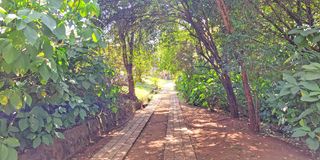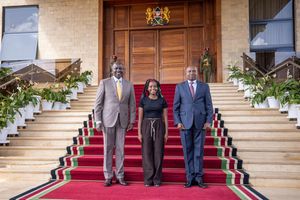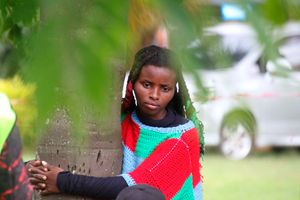Premium
A walk through the Nairobi Botanical Garden at the Nairobi National Museum

The Botanical Garden, like a small forest in the center of Nairobi.
Some time ago and back in the UK, an architect friend said to me ‘Why are we so obsessed with naming things? Why can’t we just appreciate things for what they are?’ I didn’t have a good answer for him at the time, but if he had been with us in the Nairobi Botanical Garden of the Nairobi National Museum a week last Friday, he would have got a very convincing one.
Lut and I were on a Nature Kenya tree walk, which they hold once a month. In the last 39 years living here, I have been on more Nature Kenya bird walks than I can remember, on a good number of their monthly pot-puck outings, but on only a couple of their tree walks. The first one, in City Park, was many years ago. On both occasions, our guide was Geoffrey Mwachala, Botanist and Chief of Research at Kenya’s National Museums.
It’s always a pleasure to be with someone who is not only an expert in their field but also someone who can talk about it with enthusiasm and flair. Having mastered the names of East Africa’s trees and plants, Geoffrey has been able to study them closely, compare them and talk about their characteristics and uses.
There were 15 of us – young (anyone younger than me qualifies) Kenyans and four wazungu – a mix of museum staff, Nature Kenya members and tourist guides. Geoffrey led us from near the main entrance of the museum and down a path that first runs parallel to Chiromo Road and then into a large garden that lies between the Nairobi River and the museum buildings. The site was once a quarry, and it was there that Francis Nnaggenda first created his large stone sculpture, Mother and Child. It now stands on the small roundabout just inside the entrance. Geoffrey told us that, when the garden was being set out, it was the KDF that moved it, as they were the only agency that had the necessary heavy-loading equipment. There are a few other stone sculptures along the garden paths that Geoffrey helped to lay out 30 years ago. But we were there to focus on the trees.
Before we descended the steps to the garden, Geoffrey told us that there are about 1,000 species of trees and shrubs in East Africa. As for grasses, he admitted that it is far more challenging to study them, as there is a greater diversity of species in East Africa than there are species of trees and shrubs. He also admitted that he stays clear of the grass section of the garden. Perhaps he does because, understandably, there could well be questions he would find difficult to answer!
Most of the species of trees and shrubs found in the garden were selected and planted about 30 years ago, when eucalyptus trees, imported from Australia, were cleared. However, not all are indigenous; species from other parts of Africa can thrive in Kenya – but not all do well in Nairobi. Also, not all indigenous trees, like the African Baobab, a coastal or lowland tree, doesn’t do well here. There was once a company with its office in Upper Hill called Baobab Ltd. They tried again and again to plant one in their garden, but all failed to grow. There is one, though, in the Nairobi Arboretum that was planted in 1922.
Species from many landscapes of East Africa can be found in the garden: Crotons, for example, abundant in the upland forests; Commiphora (the frankincense and myrrh family) of the bush; Nile Tulip (Markhamia lutea) of grasslands; the Meru Oak growing tall at 1,300 metres to 2,100 metres.
It seems that the business of naming trees is even more controversial than naming birds. One striking example is that all our acacias cannot now officially be called acacias. And that is a case Geoffrey has taken up himself. On a lighter note, Geoffrey noted that many plants have a name with ‘Abyssinica’ in it. He showed us two examples of Diospyros abyssinica, tall trees with a mushroom-like top that can be found across sub-Saharan Africa. Both the trees in the garden are over 100 years old. He suggested that the name Abyssinia, once used for Ethiopia, was coined before Europeans explored or settled in Africa. It meant the land south of Egypt, including the Sahel. And was there, I wonder, any connection with the word ‘abyss’, meaning a bottomless pit or the region of hell?
About how the age of trees is established, Geoffrey pointed out that in Africa it is more difficult than in Europe, where there is the summer growing season and the winter growth pause so that each growth ring of the trunk marks one year. Here, the weather is more variable. As one old European settler said ‘There’s no real weather here – it’s either raining or not raining.’ So, in the tropics, the growing season is determined by the rain, and a tree’s age can be established only by an isotope analysis. Or there is the thing called luck. Like the occasion in Mombasa when a tree was removed during an archaeological excavation and among its roots there were the remains of a Portuguese soldier, including an intact badge dating back to around 1600!
It was good that we were with several different specialists from the staff of the National Museum and members of Nature Kenya. At one point, for example, when we were discussing how many trees depend on insects, birds or bats, for fertilisation, Ben Koros, an entomologist, explained how he had located a few Indigenous custard apple trees in the museum compound after he identified swallowtail butterflies whose larvae specifically feed on their leaves.
We spent three very pleasant hours on the tree walk, and I think the Nairobi Botanical Garden is not as well known as it should be. The next tree walk will be on March 28, at Karura Forest as a contribution to making an inventory of existing trees and shrubs.
John Fox is Chairman of iDC.
Email: [email protected]





